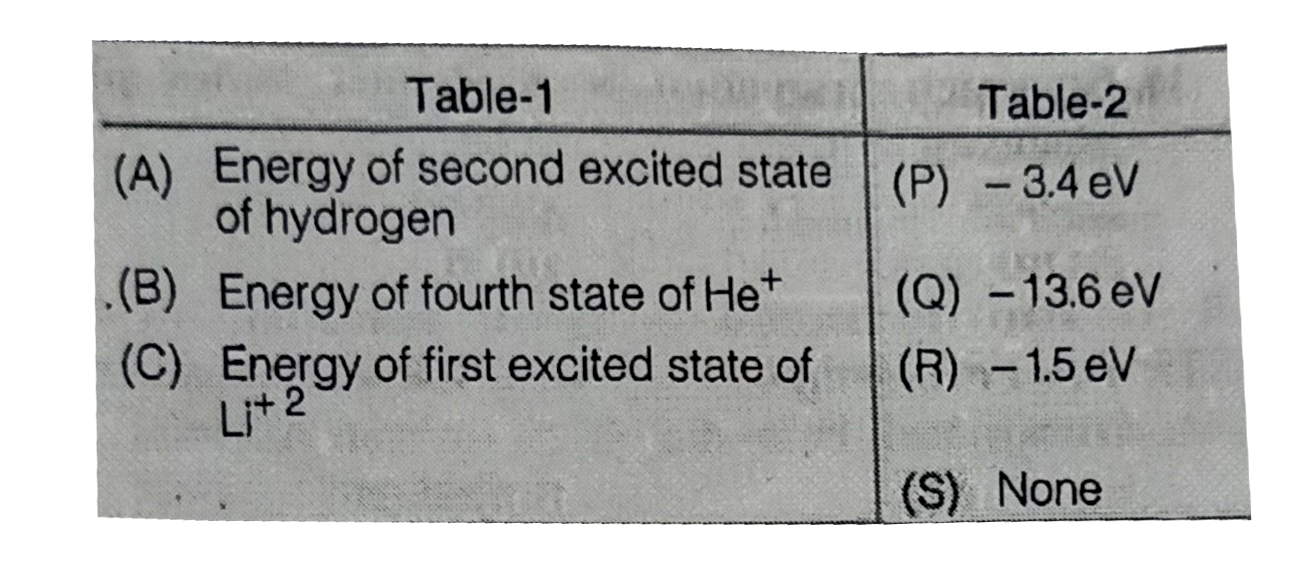A doubly ionized lithium atom is hydrogen like with atomic number 3. Find the wavelength of the radiation required to excite the electron in Li++ from to the third Bohr orbit (ionization energy of the hydrogen atom equals 13.6 eV).
The correct Answer is:113.74A∘
To solve the problem of finding the wavelength of radiation required to excite the electron in a doubly ionized lithium atom (Li²⁺) from the third Bohr orbit, we can follow these steps:
Step 1: Determine the Energy of the Electron in the Initial and Final States
The energy of an electron in the nth orbit of a hydrogen-like atom is given by the formula:
En=−13.6Z2n2eV
where Z is the atomic number and n is the principal quantum number.
For Li²⁺, Z=3.
For the first orbit (n = 1):
E1=−13.6×3212=−13.6×91=−122.4eV
For the third orbit (n = 3):
E3=−13.6×3232=−13.6×99=−13.6eV
Step 2: Calculate the Energy Difference
The energy required to excite the electron from the first orbit to the third orbit is given by:
ΔE=E3−E1
Substituting the values we calculated:
ΔE=−13.6−(−122.4)=−13.6+122.4=108.8eV
Step 3: Relate Energy to Wavelength
The energy of a photon is related to its wavelength by the equation:
E=hcλ
Where:
- h is Planck's constant (6.626×10−34J s)
- c is the speed of light (3×108m/s)
We can rearrange this equation to solve for the wavelength λ:
λ=hcE
Step 4: Convert Energy from eV to Joules
To use the above formula, we need to convert the energy from electron volts to joules. The conversion factor is:
1eV=1.6×10−19J
Thus,
E=108.8eV×1.6×10−19J/eV=1.7408×10−17J
Step 5: Calculate the Wavelength
Now we can substitute the values into the wavelength formula:
λ=(6.626×10−34J s)×(3×108m/s)1.7408×10−17J
Calculating this gives:
λ≈1.14×10−8m=114.25Å
Final Answer
The wavelength of the radiation required to excite the electron in Li++ from the first to the third Bohr orbit is approximately 114.25 Å.
---
The energy of an electron in the nth orbit of a hydrogen-like atom is given by the formula:
E1=−13.6×3212=−13.6×91=−122.4eV
E3=−13.6×3232=−13.6×99=−13.6eV
The energy required to excite the electron from the first orbit to the third orbit is given by:
The energy of a photon is related to its wavelength by the equation:
- h is Planck's constant (6.626×10−34J s)
- c is the speed of light (3×108m/s)
To use the above formula, we need to convert the energy from electron volts to joules. The conversion factor is:
Now we can substitute the values into the wavelength formula:
The wavelength of the radiation required to excite the electron in Li++ from the first to the third Bohr orbit is approximately 114.25 Å.
Topper's Solved these Questions
- ATOMIC STRUCTUREBOOK - ALLENCHAPTER - ATOMIC STRUCTUREEXERCISE - Exercise - 04[B]
10 Videos
- ATOMIC STRUCTUREBOOK - ALLENCHAPTER - ATOMIC STRUCTUREEXERCISE - Exercise - 05[A]
14 Videos
- ATOMIC STRUCTUREBOOK - ALLENCHAPTER - ATOMIC STRUCTUREEXERCISE - Exercise - 03
21 Videos
- IUPAC NOMENCLATUREBOOK - ALLENCHAPTER - IUPAC NOMENCLATUREEXERCISE - Exercise - 05(B)
7 Videos
Similar Questions
A doubly ionized lithium atom is hydrogen like with atomic number 3. Find the wavelength of the radiation required to excite the electron in Li++ from the first to the third Bohr orbit (ionization energy of the hydrogen atom equals 13.6 eV).
View SolutionA doubly ionized lithium atom is hydrogen like with atomic
. number 3. Find the wavelength of the radiation to excite the electron in
. Li++ form the first to the third Bohr orbit. The ionization energy of the hydrogen
. Atom is 13.6V.
View SolutionEnergy required for the electron excitation in Li++ from the first to the third Bohr orbit is:
View SolutionWhat will be the wavelength of radiation released in nano-metre when an electron drops from the 5th Bohr orbit to 2nd Bohr orbit in hydrogen atom?
View SolutionExcitations energy of hydrogen atom is 13.6eV match the following

View SolutionIn hydrogen atom, if the difference in the energy of the electron in n=2 and n=3 orbits is E, the ionization energy of hydrogen atom is
View SolutionFind the ratio of ionization energy of bohr 's hydrogen atom doubly liothium ion (Li2)
View SolutionA single electron orbit around a stationary nucleus of charge +Ze where Z is a constant and e is the magnitude of the electronic charge. It requires47.2eV to excite the electron from the second bohr orbit to the third bohr orbit. Find
(i) The value of Z
(ii) The energy required by nucleus to excite the electron from the third to the fourth bohr orbit
(iii) The wavelength of the electronmagnetic radiation required to remove the electron from the first bohr orbit to inlinity
(iv) The energy potential energy potential energy and the angular momentum of the electron in the first bohr orbit
(v) The radius of the first bohr orbit (The ionization energy of hydrogen atom =13.6eV bohr radius =5.3×10−11matre velocity of light =3×108m/sec planks 's constant =6.6×10−34 jules - sec )
View SolutionThe ionization energy of a hydrogen like bohr atom is 4 Rydbergs (i) What is the wavelength of the radiation emitted when the electron jumps from the first excited state to the ground state ?(ii) what is the radius of the orbit for this atom ?
View SolutionA single electron orbits a stationary nucleus of charge +Ze, where Z is a constant and e is the magnitude of electronic charge . It requires 47.2eV to excite electron from second Bohr orbit to third Bhor orbit . Find
a the value of Z
b the energy required to excite the electron from the third to the fourth Bohr orbit.
c. the wavelength of electromagnetic rediation required to remove the electron from the first Bohr orbit to infinity.
d Find the KE,PE, and angular momentum of electron in the first Bohr orbit.
e. the redius of the first Bohr orbit
[The ionization energy of hydrogen atom =13.6eV Bohr radius =5.3×10_11m, "velocity of light" =3×10−8jms−1, Planck's constant =6.6×10−34j−s]
View Solution
